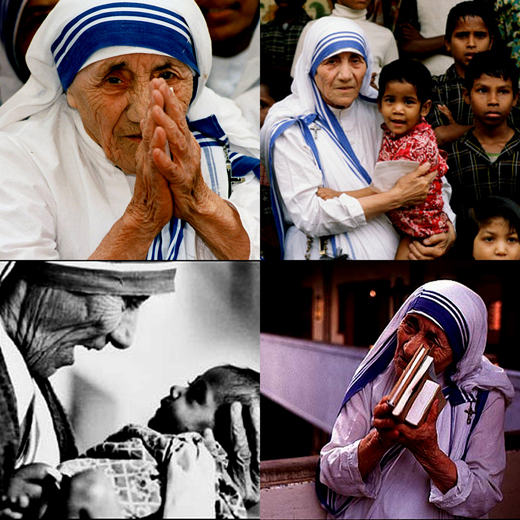Mercy, poor focus of Blessed Teresa’s canonization, events programme
www.mangaloretoday.com
Vatican City, August 13, 2016: The poor, the suffering and those who minister to them will be at the center of celebrations leading up to the canonization of Blessed Teresa of Kolkata at the Vatican.
The main event — the canonization Mass — will begin at 10:30 a.m. Sept. 4, the Vatican announced on Aug. 5.

A “family feast” for the poor, a musical, Masses and prayer vigils will precede her canonization, according to programs published by the Vatican and by the Missionaries of Charity, the order she founded.
Known as the “saint of the gutters,” Mother Teresa was revered for ministering to the sick and the dying in some of the world’s poorest neighborhoods.
Life Recap: Born Agnes Gonxha Bojaxhiu in 1910 to an ethnic Albanian family in Skopje, in what is now part of Macedonia, Mother Teresa went to India as a Sister of Loreto in 1929. Receiving what she described as a “call within a call,” she began her missionary work with the poor and laid the foundation for what would become the Missionaries of Charity.
Following her death in 1997, St. John Paul II waived the usual five-year waiting period and allowed the opening of the process to declare her sainthood. She was beatified in 2003.
The date of Mother Teresa’s canonization will coincide with the conclusion of the Year of Mercy pilgrimage for workers and ministers engaged in works of mercy.
Here are the main events planned around the canonization of Mother Teresa: Programme:
— Sept. 1, “feast for the poor and Missionaries of Charity family,” including a musical based on Mother Teresa’s life.
— Masses Sept. 2 in various languages in Rome’s Basilica of St. Anastasia al Palatino and veneration of her relics. In the evening, a prayer vigil with solemn eucharistic adoration will be held at Rome’s Basilica of St. John Lateran with Cardinal Agostino Vallini, the papal vicar of Rome, presiding.
— Catechesis Sept. 3 by Pope Francis for the jubilee celebration of workers and volunteers for mercy. In the evening, a prayer and musical meditation will be held at Rome’s Basilica of St. Andrea della Valle followed by veneration of Mother Teresa’s relics and Mass.
— Canonization Mass Sept. 4. Pilgrims will be able to venerate St. Teresa’s relics in the evening at the Basilica of St. John Lateran.
— Celebration Sept. 5 of a Mass of thanksgiving and the first feast of St. Teresa of Kolkata in St. Peter’s Basilica with Cardinal Pietro Parolin, Vatican secretary of state, presiding. Pilgrims will be able to venerate the relics of St. Teresa at St. John Lateran in the evening.
— Sept. 6, continuing veneration of the relics of St. Teresa at St. John Lateran.
— Sept. 7-8, veneration of the relics of St. Teresa of Kolkata at Rome’s Church of St. Gregory the Great, along with the possibility of visiting her room at the convent of St. Gregory.
Mother Teresa’s vision of Christianity
Mother Teresa has become a worldwide model for self-sacrifice and charity. She had a deep understanding of the teachings of Jesus Christ and she lived out these teachings as she served the world’s downtrodden. Because of her faith, Mother Teresa was able to intimately reflect on love, prayer, giving, service, poverty, forgiveness and more throughout her earthly ministry. She also had deep hope, abiding faith in God and a revolutionary vision of Christianity that we can still learn from today.

In the midst of the world’s poverty and pain, Mother Teresa showed the warm light of God’s love and compassion in us all. “You are the light of the world,” Jesus told His disciples. “Come, be my light.” Jesus similarly urged Mother Teresa in her mission. Throughout her life, she stands as a beacon of light reflecting the heart of God to those who seek Him. In the darkness of human suffering and sin, His signs of nearness and care were reflected. Mother Teresa recognized Jesus as the bread of life, that when He came into the world, He loved it so much that He gave His life for it. Jesus became the bread of life to satisfy our hunger for God and our hunger for love. Mother Teresa stressed the importance of not allowing anything to interfere with your love for Jesus. She believed that if you trust in Jesus as your joy and strength, temptations and difficulties will come, but nothing will break you.
Mother Teresa’s life was reflected not only in her work, but in her acts of service. She believed that we all have the duty to serve God where we feel called. Mother Teresa felt a calling by God to help individuals and to love each human being. She didn’t think in terms of crowds in general, but in terms of individuals. Mother Teresa believed in the power of person-to-person encounters because the person matters. Loving those around us is central to Christian life. Jesus had two primary commands for His followers. Second only to “love God” is “love your neighbor as yourself.” Our neighbors aren’t just the people that live next door to us. Our neighbors include the poor, disenfranchised and downtrodden. Mother Teresa answered this call through the fullness of her heart. She believed the fullness of our heart was a result of our actions: how we treat the leper, the dying person and the homeless. But she also believed that we need to be pure in heart to see Jesus in the person of the spiritually poorest. Her thought was that the more disfigured the image of the God was in that person, the greater our faith and devotion in seeking Jesus’ face and lovingly ministering to Him.
Long before everyone started talking about it, Mother Teresa and her sisters had gone to the margins and lived with the poor. She believed the more repugnant the work, the greater the effect of love and cheerful service. Mother Teresa shared that she would not have been able to be a Missionary of Charity had she not picked up a woman in the early part of her ministry who was eaten by rats. Feelings of repugnance are human. Mother Teresa believed that if we give our wholehearted, free service in spite of such feelings, we will become holy. The Bible tells us that we should be invested in the interest of others. Philippians 2:4 says, “Let each of you look not only to his own interests, but also to the interests of others.” This means the interests of others should be our interests too. We learn through Mother Teresa’s life the power of service. In the service to the poor, we are offered a magnificent opportunity to do something beautiful for God. When we give of ourselves with all our hearts to the poor, it is Christ whom we are serving.
Mother Teresa will always be remembered for what she said and what she did while on this earth. She started her work with no money, depending only on God to help her. Mother Teresa and her followers nursed the sick and dying, taught street children, gave shelter to the homeless, cared for the unloved and the lonely and proclaimed the Word of God. Rich and poor alike have felt inexplicably drawn into the mercy of God’s tender embrace by her example as a follower of Christ. Her selfless-love is a powerful example of what it means to love others as Christ loved us and a sign that God still loves the world today.
- IMD predicts thunderstorm for the next few days in coastal Karnataka
- Congress govt. has neglected coastal Karnataka, charges Vijayendra
- Kundapura: Grocery shop gutted in fire, losses exceed ₹4 lakh
- Puttur: 2 Hindu activists arrested for posing with machetes, posting photo in social media
- Udupi: Two sisters missing in Hiriyadka
- Udupi: 27 stolen mobile phones recovered, handed over to owners
- Mangaluru: Car goes out of control, climbs on divider near Nanthur
- 30 injured as KSRTC bus crashes into a house in Chikkamagaluru
- MoS for Railways, Somanna to flag off extended Subrahmanya Road passenger service on April 12
- Prices of over 50 commodities surged after Siddaramaiah became CM, alleges Vijayendra
- Government will bring in new law to regulate online betting, gambling: Home Minister
- MP Brijesh Chowta lays foundation for development of roads under CRIF at cost of Rs 6 crore
- Mangaluru: At least six vehicles damaged after car goes out of control of driver
- Menstruating Dalit student made to take exams outside class in Tamil Nadu
- Darshan ignites new controversy by attending film premiere during ongoing legal dispute
- Apple airlifts 600 tons of iPhones from India ’to beat’ Trump tariffs: Report
- 300 students have had US visas revoked and could face deportation: Report
- Robbers break into ATM, decamp with Rs 18L cash in Kalaburagi
- 10 days before daughter’s wedding, UP woman elopes with would-be son-in-law
- PM Modi pays tribute to Mahavir on his birth anniversary
- Ranya Rao, Tarun Raju smuggled over 31 kg of gold into India: DRI in court
- A man who quietly built world’s largest Miyawaki forest in India
- Trump reverses course on reciprocal tariffs, announces 90-day ’pause’ for all but China
- Drunk Indian flyer urinates on co-flyer in Delhi-Bangkok Air India flight
- US woman travels to this Indian village to marry her Instagram friend
- Skills and Competencies Take Center Stage at MSN Dialogue Series
- Court remands Maoist Lakshmi to six-day police custody
- Sandhya Shenoy honored with Society for Materials Chemistry Medal-2024
- White Cornus Apartment in Mangaluru
- City girl wins first place in state-level spell bee competition
- Alleged ‘Love Jihad’ Case in Mangaluru: Woman left home voluntarily, says police
- Girl fatally struck by reckless two-wheeler near Belman
- New residential complex for the judges inaugurated in Mangaluru
- Absconding accused nabbed after 8 years
- Truck with cylinders turns turtle in Beltangady
- Bhoota Kola artist dies of cardiac arrest
- Development of the country should be our goal: Ganesh Karnik
- Container truck gets stuck under Modankap railway bridge
- Truck crushes bike’s pillion rider near BC Road
- Head constable dies of heart attack
- CITY INFORMATION
- TRAVEL
- TOURIST INFORMATION
- HEALTH CARE
- MISCELLANEOUS




 Write Comment
Write Comment E-Mail To a Friend
E-Mail To a Friend Facebook
Facebook Twitter
Twitter  Print
Print 


